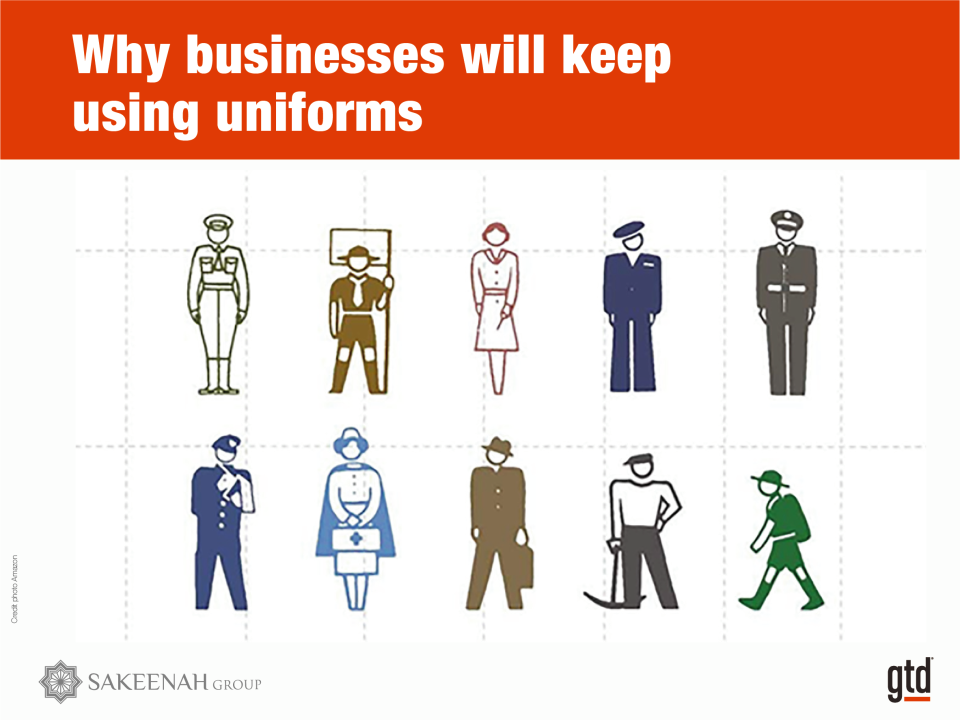Should companies continue to insist their staff wear uniforms?

A recent discussion with one of my clients employing over 1,000 people prompted me to ponder over whether the use of uniforms in business is a thing of the past and one of those things that are mindlessly followed by companies or whether there was really a business case.
The use of uniforms in businesses might look anachronistic in this age of working from home and business moguls like Mark Zuckerberg wearing casual t-shirts and jeans. But it seems that the use of uniforms by businesses is not going anywhere anytime soon.
A lot of that has to do with the psychology of clothing. In 2012, researchers at Northwestern University tested what has come to be called ‘enclothed cognition’. In one set of experiments, they took a group of students and gave them a set of tasks to do. Half were given lab coats to wear and the other half were in regular clothes. Those wearing the lab coats were more attentive and focused than those in just everyday clothes. In the next experiment, they gave both groups identical white lab coats, but one group was told it was a doctor’s coat while the other was told it was an ordinary painter’s coat. Even though they were wearing the same thing, the ‘doctors’ were found to be more attentive and focused in their tasks than the ‘painters’. The fact that what you wear affects how you perform has been replicated in other studies since then. In 2015 another study found that people wearing formal business attire performed better at tasks involving abstract cognition than those in casual clothes. A study conducted among a group of athletes in the 2004 Olympics found that those wearing red tended to perform better in combat sports because of the association of red with testosterone signaling.
Pros and Cons

For individual employees, there are advantages to working in uniform; they are great at team-building, avoid awkward discussions about inappropriate clothing, and with evidence that well-designed uniforms boost employee performance and mood. Plus, for the employees, it’s easier on the wallet. A YouGov poll in Australia in 2018 found that 68 percent of women and half of Australian men would be happy to wear a uniform to work if they could save money by avoiding having to buy clothes to wear to work. Here too there is a little psychology at play: if you wear jeans at work and at home, the lines between ‘work’ you and ‘home’ you become blurred affecting productivity. The downside is a uniform squelching employee creativity and other studies showing that employees feel more productive if allowed to wear casual clothes in the workplace.
The Customer

Although fads regarding what to wear to work have changed over the years, from becoming more casual in the 1990s with the emergence of the internet and its possibilities (in 1997 83% of US companies had casual dress policies), to a backlash after 2000 over fears that casual attire at the office was affecting productivity and promoting laxness at the office (the number of US firms with casual dress policies dropped from 53% in 2002 to 38% in 2006) to casual attire making a comeback with, according to McKinsey, 62% of Americans working from home during Covid-19. This however is restricted to the tech sector or businesses with little or no direct interaction with customers. For service sectors, uniforms are still the way to go; not because of how employees or employers feel, but what customers come to expect. According to the Harvard Business Review, studies show that 90% of retail customers prefer to leave a store empty-handed rather than ask for assistance. But customers were twice as likely to interact with uniformed employees because they associated the uniform with more expertise and expectations of better service. Its not just retail, uniforms seem to improve any kind of direct interaction with customers: a study of an airline management company found that when its staff ditched its formal uniforms, flight attendants became less professional and customers became more pessimistic about the professionalism of the airline staff in general. It’s the same reason why the British Medical Journal found in 2018 that out of a survey of more than 4,000 patients, more than half preferred a doctor to wear a white coat and a third said that what their doctor wore while treating them influenced their level of satisfaction with the care they received. All this is why the global industry for workwear is expected to become a $42.7 billion industry by 2026.
The business logic of uniforms

There is also a logic for businesses to stick with uniforms that go beyond productivity and individual employees. A survey of managers carried out by Suffolk University asked whether putting their employees into customized uniforms seemed to have an impact in exposing their business to the public. In that survey, 71.5% of managers saw customized uniforms for their employees as more effective than putting an ad in a newspaper, 74.4% said it worked better than a radio ad, 75.7% said it worked better than a billboard and 56.1% saw uniforms as working better than internet ads to showcase their business to the public. This is what, in business terms, has come to be known as 'aesthetic labor' where businesses see the appearance of their employees as an extension of their corporate identity and image.
A series of experiments carried out in 2020 showed how this also worked against competitors. What the researchers found was that if a uniformed employee gave a customer good service, the impression of the company improved. That impression did not change if the customer later received mediocre service from other uniformed employees of the same company. The good service from a uniformed employee was also found to become a yardstick by which the service of competitors was judged; hence good service by a uniformed employee tended to hurt the customer’s perceptions of a competitor where the service was not as good.
The right way and the wrong way

If the business sense of having employees in uniform means that they are not going away anytime soon, these can backfire if not handled properly. Ideally, this should be a good balance between the business’ need to preserve its corporate image and employee needs. The international courier company UPS got it right. Since 1925, it has been recognized for its iconic brown uniform which for fifty years included a jacket and police-style cap. But as the business expanded and its employees were expected to work in warmer regions, the iconic color of the uniform remained the same, but in 1968 the uniform was changed to short-sleeved shirts and baseball caps. And then again in 1991 to shorts. The employees were happy and the company has maintained its iconic image and look.
By contrast, Wal-Mart was not so lucky in 2014 when it wanted its employees to wear collared shirts and khaki pants under the blue vest uniform that Wal-Mart provided. What Wal-Mart did was insist that this change was a ‘dress code’ and not a ‘uniform’, therefore denying any responsibility for supplying its employees the new clothes it was mandating them to wear. The result was a PR disaster as employees threatened to take Wal-Mart to court and the whole episode was splashed all over newspapers globally. Not taking employees on board was also the Achilles heel when it came to Safaricom in Kenya in 2009. It simply announced new uniforms via email and instructed employees to get measured for the new uniforms. The result was 44.4% of the 600 Safaricom employees hated their new uniforms, productivity declined and more than 13% of employees said that the new uniforms contributed to their absenteeism.
Whether we like it or not, it seems that uniforms will stay in the business world for a while because they seem to have a lot to contribute. That is provided employees and their needs are also taken on board.
Swadeck Taher OSK is a Chartered Accountant (ICAEW) and a Chartered Marketer (CIM) running businesses and coaching, consulting, mentoring CEOs and entrepreneurs ranging from startups through family businesses to established top 100 companies in Mauritius. He enjoys sharing the expertise he developed over the last thirty years at senior leadership/directorship level with his clients, business partners and other budding entrepreneurs.
Swadeck is also a GTD Practitioner and a Certified GTD Trainer. He helps others experience what the Productive Experience feels like and how they too can savour stress free productivity.
Sakeenah Co Ltd is the only Certified International Partner of the David Allen Company in Mauritius.
GTD® and Getting Things Done® are registered trademarks of the David Allen Company.
Disclaimer: All images are copyright to their respective owners. If any of the images used in this article belongs to you and you wish these removed, please send me a message and I shall oblige.
Join Our Mailing List
For receiving our news and updates in your inbox directly.


